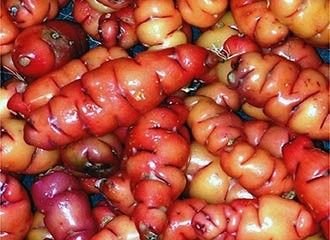Oca is another native South American tuber grown in the high Andes since pre-Columbian times and was a staple food of various ancient cultures. The finger like tubers can be white, orange, red, pinkish or purple.
Fresh ocas have a crunchy texture comparable with a carrot and a tasty sweetness. To improve its sweet flavor and culinary quality, oca is typically exposed to direct sunlight for several days prior to consumption.
The roots can be prepared like potatoes or other tubers. Traditionally they are boiled, roasted, cooked in stews or used in the famous Pachamanca. Andeans steam oca and mix it with cane syrup to produce a treat called caya or make a special chuño, which is a freeze-dried potato, out of Oca called khaya.
Flour made of khaya is used to make porridge and desserts. Oca is a good source of energy; its protein and fat content is low. Studies have revealed that it has antibacterial and antifungal properties.





























